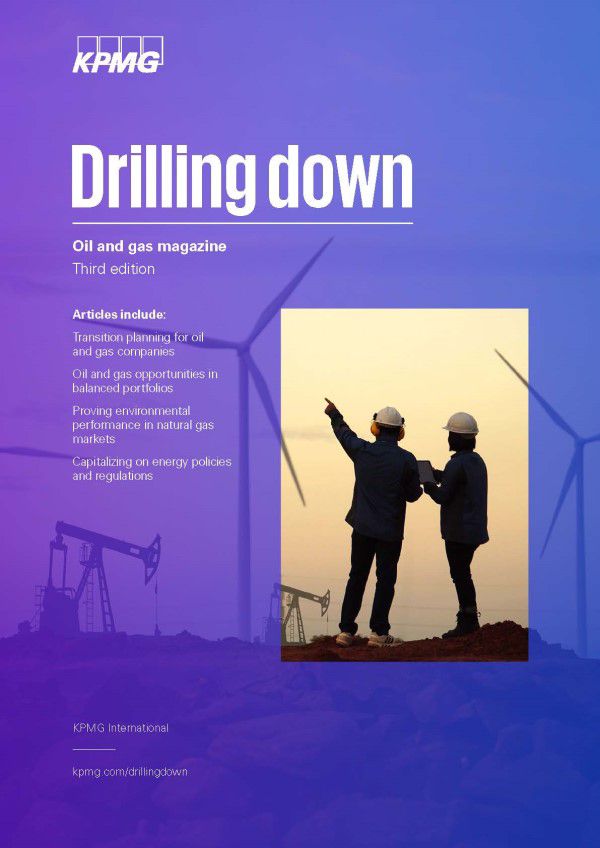By: Andrew McHardy, Partner and National Leader of the KPMG Decarbonization Hub, KPMG in Canada, Javier Mundo, Head of Energy and Natural Resources, KPMG in Mexico, Zachary Schwartz, Director, Infrastructure & Climate Advisory, KPMG in the US
As the world moves towards meeting net zero carbon emissions, many industry leaders, consumers and stakeholders are looking to the oil and gas industry to play a significant role to meet these targets. Despite renewable energy growth, the proportion of fossil fuels in global primary consumption has remained relatively stable and as of 2022 was 82%.1
How will the oil and gas industry influence the continued demand for energy while ensuring energy security, affordability, and sustainability are met?

Oil and gas companies can take a number of steps to support the energy transition beyond solely transitioning from fossil fuels. For example, measures to reduce carbon emissions can include eliminating non-emergency flaring, electrifying upstream facilities with low-emissions electricity, equipping oil and gas processes with carbon capture, utilization and storage (CCUS) technologies, and expanding the use of blue hydrogen.
In many cases, energy transition involves diversifying company portfolios with various assets related to sustainable energy sources and innovative technology. (see Drilling Down Third edition, “Oil and gas opportunities in balanced portfolios.”)
This means using revenues from today’s businesses to create future business models and revenue streams.

While still in the earlier stages of deployment, AI’s ability to digest massive amounts of complex, unstructured data and deliver interpretations and predictions makes it an important tool in determining how to reduce our carbon footprint. It’s already helping companies make more informed decisions in the transition to lower carbon operations, including moving the dial on measuring, tracking and forecasting greenhouse gas (GHG) emissions reductions.
Key factors in creating a transition plan
Knowing when and where to invest is not easy. Indeed, most oil and gas companies today need help to develop their transition plans and articulate their positions to their stakeholders. Leaders can start by considering the following factors:
- What : Knowing what new models or technologies to invest in can be challenging. We are seeing significant investment flow into various options such as CCUS, renewables, hydrogen, electric vehicle charging, biogases, and biofuels. We are also seeing some oil and gas companies look at new opportunities that leverage their embedded capabilities or play into future growth areas, such as the mining and processing of battery minerals. Every company’s list of opportunities will be prioritized slightly differently depending on their ambition, objectives and strengths.
- When : The timing of investments is also a big challenge. Oil and gas companies are developing new energy capital assets using a phased approach instead of committing to the large capital project up front. Large projects can be broken into smaller phases to limit their exposure to market volatility at any given time. Oil and gas companies will only expand given the market economics makes sense. Ideally, you want to scale up as demand rises. However, demand for alternative sources has yet to materialize in some markets. That means that oil and gas companies should start building partnerships and ecosystems of customers, providers and generators that can work together to raise demand and supply in tandem. The good news is that there are incentives and funding mechanisms available that could help reduce the demand risk and make funding more viable.
- Where : The financial incentives and business confidence created by the US Inflation Reduction Act (IRA) have helped the US emerge as a key competitor for alternative energy investment. Yet other markets are also developing attractive incentives for investors in key energy sectors. The trick is in knowing where to invest to maximize value globally. There could be a unique role to play in helping shape and address the energy agenda in developing and emerging markets where oil and gas companies have existing relationships. Local supply chain capabilities and available skills will also influence where oil and gas companies choose to invest.
- How : There are many avenues of entry and expansion depending on the sector or technology. Options include investing in technologies, funding start-ups, or snapping up key value chain players. We believe that every avenue will require oil and gas companies to develop ecosystems and partnerships to execute their transition plans – whether to drive demand, create secure supply chains, embrace innovation or create new business models. Again, the available incentives could affect how those partnerships are formed and structured.
Bringing the plan together
A checklist for a successful transition plan can include the following items:
- We have a clear understanding of where our Scope 1 and 2 emissions are as a business.
- We know where the biggest climate and sustainability-related risks and opportunities lie and have a plan to respond.
- We have clear plans on what levers are available to us and which ones we will pull in the short, medium and long term to reduce our emissions.
- We are confident that we know the financing opportunities open to us for sustainable investments and the impact our transition will have on our balance sheet.
- We are regularly engaged with our supply chain, customers, and investors on climate and sustainability.
- We have an operating model and corporate structure which will maximize our flexibility in a net-zero world.
- We have clear roles and responsibilities on delivering, tracking, and reporting in our business on our climate and sustainability progress.
- We have climate and sustainability embedded into all of our finance systems, operations, and ways of thinking and investing.
- We have reliable and accessible data on our carbon emissions as well as other metrics to track our biggest risks and opportunities.
- We know what it takes to transition our business to hit our climate and sustainability ambitions and how to show that we are proactively taking action.
Case in point: Leveraging carbon offsets to support emission reductions goals
Client challenge
A leading multinational pipeline and energy company needed to develop and implement a carbon offsets program to support their emissions reductions goals beyond 2030.
Program requirements included:
- Understanding how carbon offsets are used both globally and among their industry peers
- Identifying criteria for the evaluation of incoming risks and opportunities
- Developing and implementing a carbon offsets strategy in alignment with corporate priorities.
How KPMG helped
To support this program, KPMG professionals began with a current state, market, and peer analysis that involved iinterviewing internal stakeholders to understand operational preferences and public commitments. They identified offset leading practices at the global and industry-sector levels and reviewed compliance requirements, market trends, risks and opportunities. They also developed guidance for offset use.
The next step was to conduct an evaluation workshop that identified seven foundational offset principles and seven criteria for the evaluation of quality offsets. The KPMG team also provided educational sessions on factors affecting offset prices and conducted exercises involving criteria threshold-selections, criteria prioritizations, and case study evaluations.
Results of the workshop were incorporated into an evaluation tool that enabled a user to assign a grade for each potential offset project to a specific evaluation criteria. Output was ranked according to potential offset opportunities in alignment with corporate priorities established in the workshop.
Benefits
With the support and guidance of KPMG, the client was able to develop a strategic pathway to the implementation of carbon offsets. This included a number of transaction opportunities involving:
- Co-benefits aligned to existing decarbonization and abatement plans
- Options for internal offset use and value chain partnerships
- A voluntary-versus-compliance usage approach.
Moving forward with confidence
In the coming years, the goal is to strike a balance between reducing carbon emissions and ensuring energy security. KPMG oil and gas professionals work with companies across the energy sector to develop and execute their portfolio transition plans. Based on this experience, we suggest that oil and gas executives consider the following objectives as they work to balance and shape their portfolios:
- Set a clear plan. Markets and regulators want to see ambition in your transition plan, but they also want to see certainty. Be clear about your strategy, develop clear and measurable objectives and then focus on delivering on them.
- Make smart deals. Whether you want to recycle capital to fund new projects or snap up a value chain partner to improve vertical integration within a new sector, striking smart deals and partnerships will be key to success.
- Articulate your narrative. Tell the markets where you want to invest and what role you expect to play in the transition. But also be clear about your plans and expectations for the conventional energy side of the business.
Becoming ESG assurance-ready
Energy companies are under growing pressure for environmental, social, and governance (ESG) assurance, particularly from shareholder activists and investors, and from regulators looking to hold them accountable and curtail the prevalence of greenwashing.
In a recent report by ThoughtLabs sponsored by KPMG,3 these companies were found to surpass other industry sectors in ESG reporting:
- 64 percent of energy and natural resources companies report ESG disclosures in the public domain versus 56 percent of all companies.
- 17 percent of energy and natural resources companies reporting in the public domain provide reasonable assurances regarding ESG disclosures versus 14 percent of all industries.
More than half of leading companies in energy and natural resources agree that digital tools are key to achieving ESG assurance.4 All leaders have largely or fully implemented digital solutions to collate ESG and other non-financial information, an area where energy and resources firms are well ahead of other industries.

Case in point: Acquiring ESG assurance
Client Challenge
A major oil and gas producer was seeking third-party assurance regarding Scope 1 and Scope 2 carbon emissions, as well as multiple other ESG metrics such as water usage and workforce diversity. The assurance was also needed to validate baseline data to be used in target setting and for projections used in scenario analysis.
How KPMG helped
KPMG professionals completed a risk assessment focused on gaining an understanding of the reporting and control environment, determining materiality thresholds, and understanding target-setting exercises. Team members planned various assurance procedures such as remote site visits and reconciling source data to obtain sufficient and appropriate assurance evidence. The KPMG team also identified significant risks and material issues.
Benefits
KPMG professionals helped the client:
- Revise various assumptions that were based on outdated factors
- Align the definition and calculation methodology of metrics across different geographies
- Publish a detailed assurance statement along with a sustainability report provided to stakeholders such as investors.
1 Source: Energy Institute, in association with KPMG International and Kearney. “2023 Statistical Review of World Energy.” 2023.
2 The Globe and Mail, October 25, 2023
3, 4 Becoming ESG Assurance Ready: energy and natural resources sector, a report for KPMG by ThoughtLab,” August, 2023
Related content
Contact us
Connect with us
- Find office locations kpmg.findOfficeLocations
- kpmg.emailUs
- Social media @ KPMG kpmg.socialMedia








